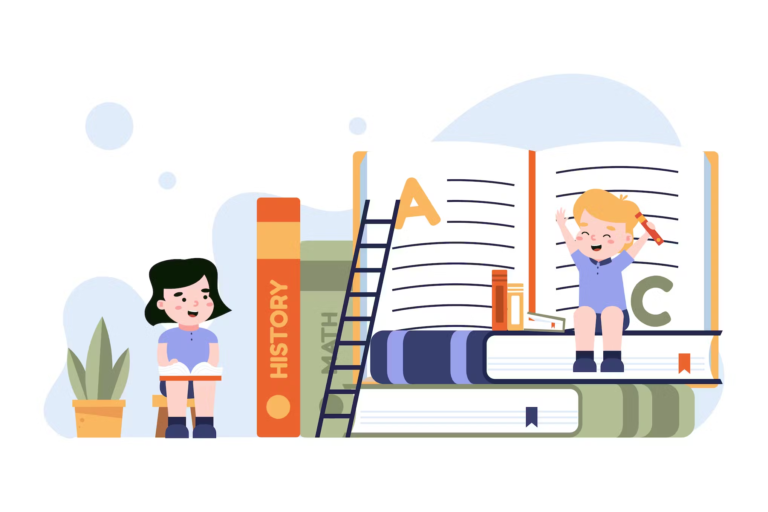What Are The Different Types Of Children's Books?

For young and aspiring writers, the journey of becoming a writer often traces its roots back to the enchanting tales of everyday heroes like the boy next door acquiring superpowers and becoming the friendly neighborhood Spiderman.
Nostalgia wraps around us as we recall the nights when our parents would read us bedtime stories, laying the foundation for our love of literature and perhaps inspiring the desire to one day create our own inspiring stories.
For those wanting to reminisce about their childhood and pen their own children’s books, the possibilities are as boundless as a child’s imagination. The world of children’s literature offers a diverse range of genres and styles, inviting writers to explore and experiment with storytelling.
Whether you’re drawn to the simplicity of illustrated books or inclined toward building narratives filled with meaningful themes, the options to explore your creativity are vast. In this article, we will discuss the different types of children’s books and their genres to help guide you on your writing expedition.
10 Most Popular Types Of Children's Books
Children’s books come in various genres and formats, catering to different age groups and interests. The popularity of specific types of children’s books can vary over time and across cultures. However, some of the most popular types of children’s books include:
1. Board Books
Board books are for very young children aged from 1-3 years. These books have illustrations or pictures with little to no text to entice infants and ignite their imaginations.
They contain bright colors, consist of introductory letters, and are no more than 100 words or even fewer. They can also add “touch and feel” elements so babies can learn to use their senses.
Their pages are made of hardcovers to withstand the tearing, chewing, or throwing of toddlers without being easily ruined.
2. Picture Books
Picture books are for children aged 3-8 whose interest lies in the images used in the books. These books can have relevant text or no text at all. It is the pictures that tell a story in a sequence. They are at most 32 pages and are under 1000 words.
Since the children reading these books are wiser than the children that read board books, writers can tell a story of some child or animal going on an adventure or resolving an issue and save the day.
Picture books will not only build reading interest in children but also allow you to play your role as a compelling storyteller.
These books are an excellent choice for parents who want their children to use their brains and make a story, making them learn how to brainstorm.
The pictures in these books are primarily of vibrant colors, and the story portrayed is simple, with a moral lesson at the end.
Bring Your Characters To Life And Create Timeless Stories With Our Children's Book Ghostwriting Team.
3. Rhyming Books
Rhyming books are super fun and exciting to read. Children love the use of repetitive words and introduce themselves to the language in a simple but enjoyable way.
These books are also great for honing children’s speaking and reading skills. Most of these books contain poetry or short poems or a short story.
Parents can use voice inflections to show emotions while reading the book, and the children get to learn which words require what emotions and how to read them.
4. Informational Books
These are books or magazines which contain facts and information for kids. An informational book for kids usually has an easy-to-understand language, exciting facts, or even fun activities for children to try.
These books are primarily nonfictional, and their stylization is mostly straightforward. The subject matter is always something which children are learning at their age.
These books mainly convey animals, plants, seasons, or countries, and they aim to present kids with these elements and make learning fun for them.
5. Poetry Books
These books can contain a short story within the poem or represent a scenario that the writer is describing.
Poems build interest, curiosity, and love for words and rhyming. They want to erupt emotions within the children and make reading more playful.
The book could either contain one poem in a story format or a collection of poems compiled in one book by the same author.
6. Interactive Books
These types of children’s books specify some activity in the book or command children to do an action.
For instance:
“Red for big and blue,
Clap just once
And then you’re through.”
In the following verse above, the poem states to clap once, which promotes a movement by children.
Interactive books are another fun way of learning to take commands or perform a stated action and understand the language more deeply.
7. Fairytale Books
These books are the most believed by children. Every kid enjoys reading fairy tales where a prince fights a monster or a princess marks a journey to self-discovery and adventure.
Fairy tales often have happy endings and a moral lesson at the end of the story, which not only becomes an enjoyable reading experience for kids but also teaches kids some basic life lessons through storytelling.
Fairytales target young teens or kids under 8. Children will always be intrigued by princesses, witches, dragons, and castles. Therefore, these children’s books will be around for a while.
8. Folklore Books
One of the most popular types of children’s books is a myth-related book, which allows children to explore the mystical literary world showcased in the book.
Folklore is stories passed down from one generation to another. These stories either tell a moral behind a story or introduce the young readers to their culture.
Some of the children’s most popular folklore books are Rapunzel, The Girl Who Spun Gold, The Phoenix of Persia, Zomo the Rabbit, etc.
9. Young Adult Books
Young adult books’ audience ranges from the age of 12 and above, targeting young teenagers. Back in the day, books were available in two categories, one for young children and the other catered to adults above 18.
These books are not suitable for the youth but also work well with adults. The books could be fiction or nonfiction, containing thematic stories or appropriate information.
Unless published in a comic format, young adult books contain no pictures or illustrations but only text. It is the writer’s job to hook the readers and compel them to keep reading.
Their word count is larger (up to 60000), and books could be divided into series and follow a more complex plot. The main focus of these books is to show the character evolving into a better person, becoming inspirational in the process.
10. Books To Learn Counting Or Alphabets
These are the types of children’s books suitable for infants or toddlers in their learning phase or who have just joined schools.
These books often contain alphabets or counting up to 10, 100, or even 1000. It either includes objects or characters starting with the stated letter or showing the number of numbers written on the book, such as ‘2 apples’.
Don’t let your manuscript go unseen. Let Hancock Ghostwriters’ team of skilled book editors bring out the best in your story. Reach out now, and let’s make your book a standout success.

Common Types Of Children’s Book Genres
When writing a fictional children’s book, your options of genres are limitless. You can choose from popular genres such as fantasy, horror, science fiction, and history.
Let us discuss each of these briefly.
1. Fantasy
This type of children’s book genre allows readers to indulge in their imaginary world full of magic, madness, and adventure.
Most of the plots follow the same route of a character undergoing a magical land exploring fairies, magic forests, unicorns, and other fantasy elements.
2. Horror
Everyone loves hearing scary stories that force them to hide under their blanket. The fear of the unknown is both terrifying and exciting to children.
This genre is suitable for young teenagers who can handle the horrifying details of such books. The writers must find the right balance in keeping the story spine-chilling and impactful in the reader’s mind.
3. Science Fiction
Science fiction is a popular genre for comic books. The technological and scientific elements of the book are both engaging and informative for the readers.
Superhero stories are also a subcategory of science fiction often used by Marvel and DC Comics. Some of the most popular sci-fi stories are Iron Man, V for Vendetta, Dune, etc., which have also come to life on big screens.
4. History
History is the perfect type of children’s book genre for the audience who is more geeky. These books allow readers to learn something new and learn about the past.
Some famous history books for children are See Inside the History of Britain, Heroes of the Revolution, A History of the World in 100 Objects, etc.
5. Other Genres
Other types of children’s book genres are science, mystery, thriller, and the list can go on and on. We suggest that you expand your niche and try out new genres to polish your skills as a writer.
If you want to create engaging and imaginative children’s books, read our blog on “10 Children’s Book Ideas“. This blog can serve as a valuable resource for aspiring authors and storytellers.

Conclusion
In the enchanting world of the different types of children’s books, the options are as diverse as the imaginations they inspire. Whether it’s the vibrant allure of picture books or the educational depth of informational literature, each type serves a particular purpose in shaping young minds.
At Hancock Ghostwriters, we specialize in capturing the whimsical essence of children’s imaginations through our expertly crafted stories. With a deep understanding of the enchanting world of children’s literature, our dedicated team of writers brings to life captivating tales that ignite the joy of reading in young minds.
So, step into the enchanting world of Hancock Ghostwriters, where stories come alive, and imaginations take flight. Together, let’s set sail on a journey to inspire the next generation of readers!
Ready To Share Your Story?
Our Children's Book Ghostwriting Services Are Here To Help You Create Captivating Tales For Young Readers.
FAQs
What are the types of children’s books?
The different types of children’s books cater to different age groups and interests, including board books, picture books, chapter books, informational books, and poetry books.
How are children’s books classified?
Children’s books are classified based on various factors, including age group, genre, and reading level. The distinct formats, such as board books, picture books, chapter books, and young adult novels, each cater to specific age ranges and developmental stages of young readers. These classifications help readers, educators, and parents identify suitable reading materials that align with children’s cognitive and emotional needs.
What are the main features of children’s literature?
The main features of children’s literature include engaging storytelling, age-appropriate language, vibrant illustrations, relatable themes, and often, a focus on moral or educational content to cater to young readers’ developmental needs and interests.

